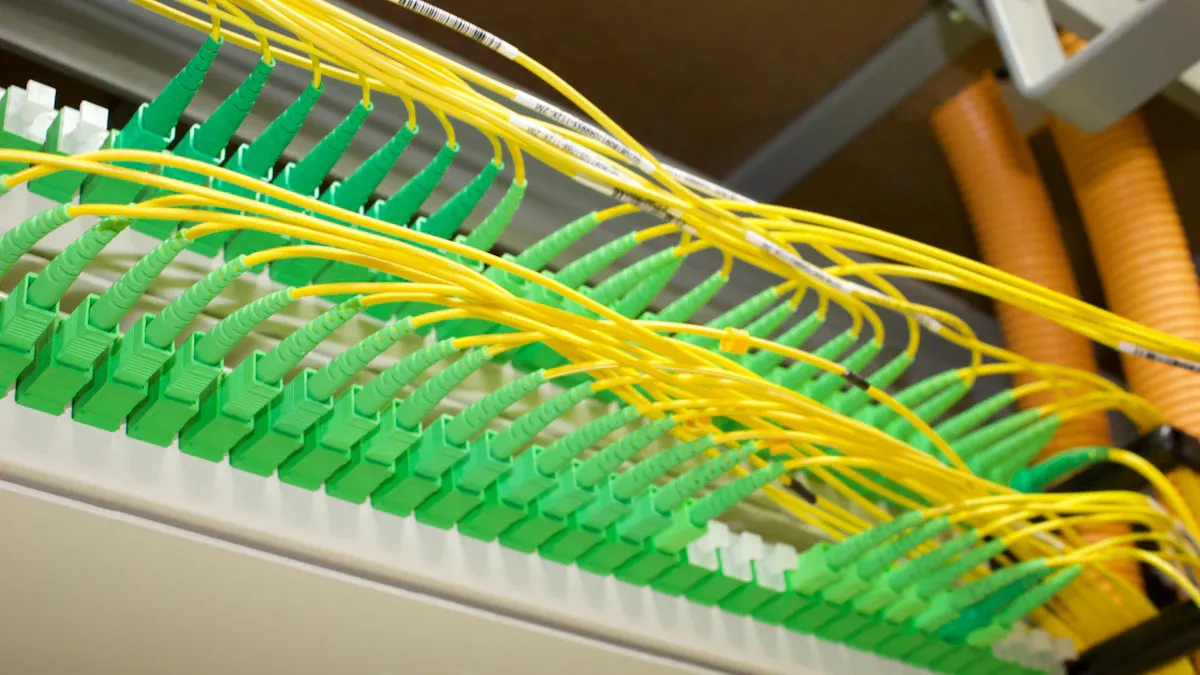Manufacturer Of High Quality Data Cable
Manufacturer Of High Quality Data Cable

If you want the best sound for your TV or soundbar, HDMI ARC often gives better results than optical cables. You want clear sound when you watch movies or play games at home. The right connection can support more advanced audio types, make setup easier, and work better with your devices. Think about what equipment you have and what features are most important to you before you choose between HDMI ARC and optical.
l HDMI ARC gives better sound. It works with new audio formats like Dolby Atmos. This makes it great for movies and games.
l Optical cables work best with older devices. They give clear sound without noise. But they do not support new audio features.
l HDMI ARC makes setup easy. You only need one cable for sound and video. You can use your TV remote to control it.
l Pick HDMI ARC if you want to be ready for the future. It will work with new sound formats and tech as they come out.
l Always check if your devices have HDMI ARC. This helps you get the best home entertainment.
When you look at sound quality, you want the best. HDMI ARC and optical cables both send sound from your TV to speakers. But they do not work the same way. HDMI ARC can send more audio channels and better formats. Optical cables only give you basic surround sound or stereo.
Here is a quick list of the main differences:
Feature | HDMI ARC | Optical Cables |
Channels Supported | Up to 8 channels (compressed) | Up to 2 channels (PCM) |
Audio Formats Supported | Dolby Digital, DTS, PCM, etc. | Dolby Digital, DTS (lossy) |
Lossless Formats | Yes (e.g., Dolby TrueHD, Atmos) | No (limited to lossy formats) |
Sound Quality | Higher quality, more immersive | Limited to stereo sound |
HDMI ARC gives you fuller and clearer sound. This is important if you want to hear every sound in movies. It also helps you enjoy music with strong bass and sharp highs.
HDMI ARC is better because it works with advanced audio formats. Optical cables cannot use these formats. With HDMI ARC, you can get Dolby Atmos, Dolby TrueHD, and DTS-HD Master Audio. These formats make sound feel like it is all around you. This is great for new soundbars and home theaters.
Here is a chart that shows which audio formats each cable can use:
You can also see the differences in this table:
Audio Format | HDMI ARC Support | Optical Cable Support |
Lossless Audio Formats | Yes | No |
Dolby Digital Plus | Yes | No |
Dolby TrueHD | Yes | No |
DTS-HD Master Audio | Yes | No |
Dolby Atmos | Yes | No |
Multichannel Audio | Yes | No |
2-channel PCM | Yes | Yes |
Dolby Digital | Yes | Yes |
DTS | Yes | Yes |
Tip: For the best sound in movies, games, or music, use HDMI ARC if your devices let you. You will hear more sounds and have a better time listening.

You can connect your TV to a soundbar or AV receiver using HDMI ARC. This connection lets you send audio from your TV to your speakers with just one cable. You do not need extra wires for sound. Most modern TVs have an HDMI port labeled "ARC." You should look for this label when setting up your system. Soundbars and receivers also need to support HDMI ARC for everything to work smoothly.
Here is a quick look at how HDMI ARC compares to traditional HDMI:
Feature | HDMI ARC | Traditional HDMI |
Audio Return Capability | Yes | No |
Bandwidth | Approximately 1Mb | N/A |
Supported Audio Formats | Dolby Digital 5.1, DTS 5.1, etc. | N/A |
Connection Method | Single HDMI cable | Multiple cables required |
You get these benefits when you use HDMI ARC:
l You only need one cable for both video and audio.
l You can control your soundbar or receiver with your TV remote.
l You can enjoy surround sound without extra setup.
If your devices do not support HDMI ARC, you can use adapters to make them work together.
Tip: Always check your TV and audio device for the "ARC" label before you buy new cables.
HDMI ARC supports several audio formats. You can listen to stereo sound or enjoy surround sound with Dolby Digital and DTS. The bandwidth for HDMI ARC is about 1.441 Mbps. This means you get good quality, but not the highest possible. If you want even better sound, HDMI eARC offers more bandwidth and supports advanced formats.
Here is a table that shows what HDMI ARC and HDMI eARC can do:
HDMI ARC | HDMI eARC |
Supports basic compressed audio formats (PCM, Dolby Digital, DTS 5.1) | Supports higher-resolution, uncompressed audio formats (Dolby Atmos, DTS:X, Dolby TrueHD, DTS-HD Master Audio) |
You can use HDMI ARC for most movies, games, and TV shows. If you want the best sound, look for devices with HDMI eARC.
Note: HDMI ARC gives you clear and strong sound for everyday use. For high-resolution audio, HDMI eARC is the better choice.

Optical cables are also called TOSLINK cables. They use light to send sound signals. You will not see electricity in these cables. A tiny laser inside your device turns sound into light flashes. The cable moves these flashes from your TV or game console to your soundbar or AV receiver.
Here is how optical cables work:
l Fiber optic cables use laser light to send digital sound.
l TOSLINK cables send sound as light, not as electricity.
l The digital optical port on your device sends uncompressed PCM audio.
l The cable changes electric sound signals into light waves.
l Optical cables block interference from other electronics, so the sound stays clear.
l You can use long cables without losing much sound quality, which helps in big rooms.
Tip: If you want to avoid buzzing or static from other electronics, optical cables protect your sound from interference.
Optical cables support many common audio formats, but they have limits. You can get clear stereo sound and basic surround sound. But optical cables do not work with the newest or most advanced audio formats.
You can use optical cables for:
l Lossless 2.0 (stereo) PCM audio
l Compressed Dolby Digital 2.0/5.1 and Dolby Digital EX
l Compressed DTS Digital Surround, DTS-ES Matrix 6.1, and DTS-ES Discrete 6.1
But optical cables do not support 7.1 soundtracks or high-definition audio like Dolby TrueHD or DTS-HD Master Audio.
Here is a table with some technical details:
Feature | Description |
Length Limitations | Most TOSLINK cables work up to 15 meters (49 feet). |
Maximum Audio Quality | Can handle 24-bit/192 kHz with the right hardware. |
Bandwidth Limitations | Cannot carry advanced formats like 7.1ch LPCM or Dolby Atmos. |
Noise Resistance | Not affected by most common noise sources. |
Note: Optical cables work well for most TVs and soundbars. But if you want the newest surround sound, you may need HDMI ARC or eARC.
You want great sound for movies and games. HDMI ARC lets you use audio formats like Dolby Atmos and DTS:X. These formats make sound come from all around you. Optical cables only give you basic surround sound, like Dolby Digital and DTS. With optical, you get stereo or compressed 5.1 surround sound. HDMI ARC gives you more channels and higher bandwidth. This means the sound is richer and fuller.
Feature | HDMI ARC | Optical Audio |
Audio Formats | Dolby Atmos, DTS:X, Dolby TrueHD | Dolby Digital, DTS |
Channels Supported | Up to 8 (compressed) | Up to 2 (PCM), 5.1 (compressed) |
Sound Experience | Immersive, multi-dimensional | Basic surround or stereo |
Tip: For better surround sound, pick HDMI ARC for your home theater or soundbar.
You need to check if your devices work with these cables. HDMI ARC works with most new TVs and soundbars. Optical cables are used with older devices. HDMI ARC started in 2009, so it is on newer models. Optical cables have been around since the 1980s. New TVs may not have many optical ports.
Feature | HDMI ARC | Optical Audio |
Year Introduced | 2009 | 1980s |
Compatibility | Newer devices | Older devices |
Convenience | Simplified connection | Requires separate cable |
HDMI ARC can have problems with interference from other electronics. Optical cables use light, so they block interference better. You get a steady connection with optical, even with lots of devices nearby.
You want setup to be easy. HDMI ARC uses one cable for both audio and video. Your TV and soundbar can talk to each other. The connection often finds the right audio format by itself. You can use your TV remote to control the soundbar. Optical cables need a separate cable just for sound. You might need extra devices or settings for surround sound.
HDMI ARC setup is simple. You plug in one cable and your devices connect. Optical cables may need you to change settings or use adapters. HDMI ARC saves you time when setting up.
Note: HDMI ARC makes setup quick and easy. You can use one remote for everything.
You should know what each cable cannot do. HDMI ARC supports uncompressed 5.1 surround sound. It cannot do uncompressed 7.1 sound unless you use eARC. Optical cables only support uncompressed stereo or compressed surround sound. They do not work with advanced formats like Dolby Atmos.
l HDMI ARC can have problems with stable audio output.
l You might see issues with the CEC protocol, which controls devices through HDMI.
l Device settings can cause problems, especially with many HDMI devices.
Optical cables have their own limits. They cannot send uncompressed multi-channel audio. The cable can be up to 50 feet long without losing signal quality. HDMI ARC cables lose signal after about 15 to 25 feet unless you use special cables.
Cable Type | Maximum Length | Signal Quality Impact |
Standard HDMI | 15ft | Signal gets weaker after this length |
HDMI 2.0 Passive | 25ft | Signal gets weaker after this length |
Active HDMI 2.0 | 100ft | Signal stays strong over long distances |
Standard Optical | 50ft | Signal stays strong over long distances |
l HDMI ARC works with new audio technology, but only if your devices support it.
l Optical cables are good for long distances, but you miss out on the newest sound formats.
Tip: If you want the latest audio and future upgrades, HDMI ARC is best. If you need a long cable or have old devices, optical is a good choice.
If you want easy setup and great sound, use HDMI ARC. Most new soundbars work best with HDMI ARC. This cable sends both sound and video. You can use your TV remote to control the soundbar. HDMI ARC lets you hear better sound formats, like Dolby Atmos, if your devices allow it. If your TV or soundbar is older, use an optical cable. Optical still gives clear sound, but you might miss some features.
Here is a table to help you choose:
Factor | HDMI ARC | Optical |
Compatibility | Best for new soundbars and TVs | Good for older devices |
Audio Quality | Supports advanced formats | Limited to basic surround |
Setup | Simple, one cable | May need extra cables |
Tip: HDMI ARC is simple and gives better sound. Use optical if your gear is old or you need a longer cable.
Home theaters use many speakers for big sound. HDMI ARC supports more sound types and channels than optical. You get surround sound and better timing between TV and speakers. HDMI ARC also means fewer cables to connect. Optical only sends sound, so you need more wires and might have sync problems.
Feature | HDMI ARC | Optical Cables |
Audio Format Support | More formats and channels | Limited support |
Video Signal | Yes | No |
Cable Management | Easier, fewer cables | More cables needed |
Synchronization | Better | May have issues |
Note: HDMI ARC gives you better sound and less mess for home theaters.
You want your system to work for years. HDMI ARC supports new sound technology and higher speeds. This means you can use new features later. Optical cables do not work with the newest sound formats. If you plan to upgrade your TV or speakers, HDMI ARC is the best choice.
Feature | HDMI ARC | Optical Cables |
Bandwidth | High, supports new formats | Limited |
Surround Sound Support | Yes, including Dolby Atmos | Only older formats |
Audio Return Channel | Yes | No |
Future-Proofing | Ready for new tech | Not flexible |
l Pick HDMI ARC if you want new audio features.
l Use optical if your devices do not have HDMI ARC or you need a long cable.
You want the best sound for your home entertainment system. HDMI ARC and optical cables both help you connect your TV to speakers or soundbars. Each option has strengths and weaknesses. You need to think about your devices, your room, and your future plans.
If you use a new TV or soundbar, HDMI ARC gives you more features. You get better sound formats like Dolby Atmos. You also enjoy easy setup with one cable. Your TV remote can control your soundbar. This makes watching movies or playing games simple and fun.
Optical cables work well with older devices. You get clear sound without interference. You can use longer cables if your room is big. Optical cables do not support the newest audio formats. You miss out on some surround sound effects.
Here is a quick checklist to help you decide:
l Check your TV and soundbar for HDMI ARC ports.
l Look at the audio formats you want to use.
l Think about cable length and room size.
l Plan for future upgrades.
Note: You should always match your cable choice to your equipment and listening needs. If you want the latest sound technology, HDMI ARC is the best pick. If you need a simple, long connection, optical cables work well.
Your Need | Best Choice |
Advanced sound formats | HDMI ARC |
Older devices | Optical Cable |
Easy setup | HDMI ARC |
Long cable runs | Optical Cable |
You now know the main differences. You can make a smart choice for your home. Enjoy your movies, music, and games with great sound!
You have learned how HDMI ARC and optical cables are different. HDMI ARC gives you better sound and works with new audio formats. It is also easier to set up. Optical cables are good for older devices. They keep sound clear because they block interference.
l Use HDMI ARC if you want the best sound or have a new system.
l Use optical cables if your devices are old or you want something simple.
If you want to know more, read articles that talk about sound quality, how the cables work with devices, and what features they have.
You cannot use both at once for the same audio output. Your TV or soundbar will only send sound through one connection. Choose the cable that matches your needs and set your device to use it.
HDMI ARC only affects audio. It does not change video quality. You still get the same picture, no matter which cable you use for sound.
Check if both your TV and soundbar support HDMI ARC. Use the correct HDMI port labeled "ARC." Make sure you turn on CEC or ARC settings in your TV menu.
Optical audio gives you clear sound for games. You get stereo or basic surround sound. For advanced effects like Dolby Atmos, use HDMI ARC if your devices support it.
You do not need a special HDMI cable for ARC. Most standard HDMI cables work. For the best results, use a high-speed HDMI cable, especially with longer runs.